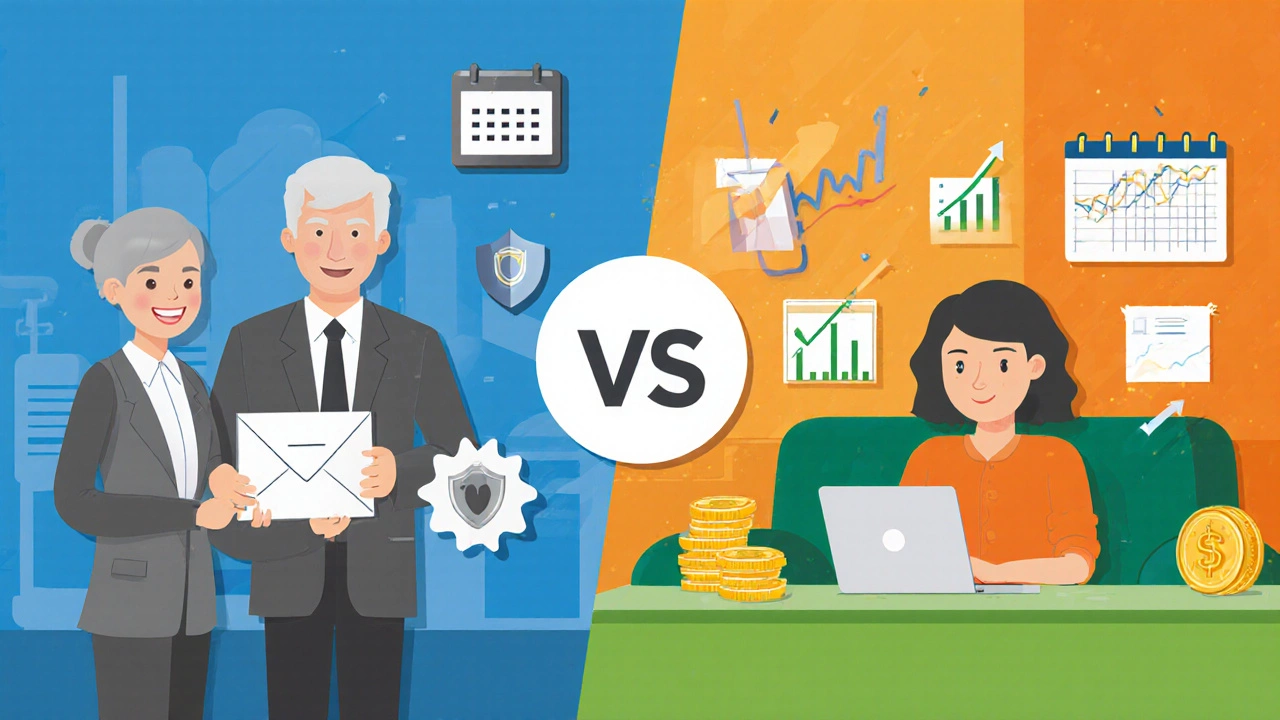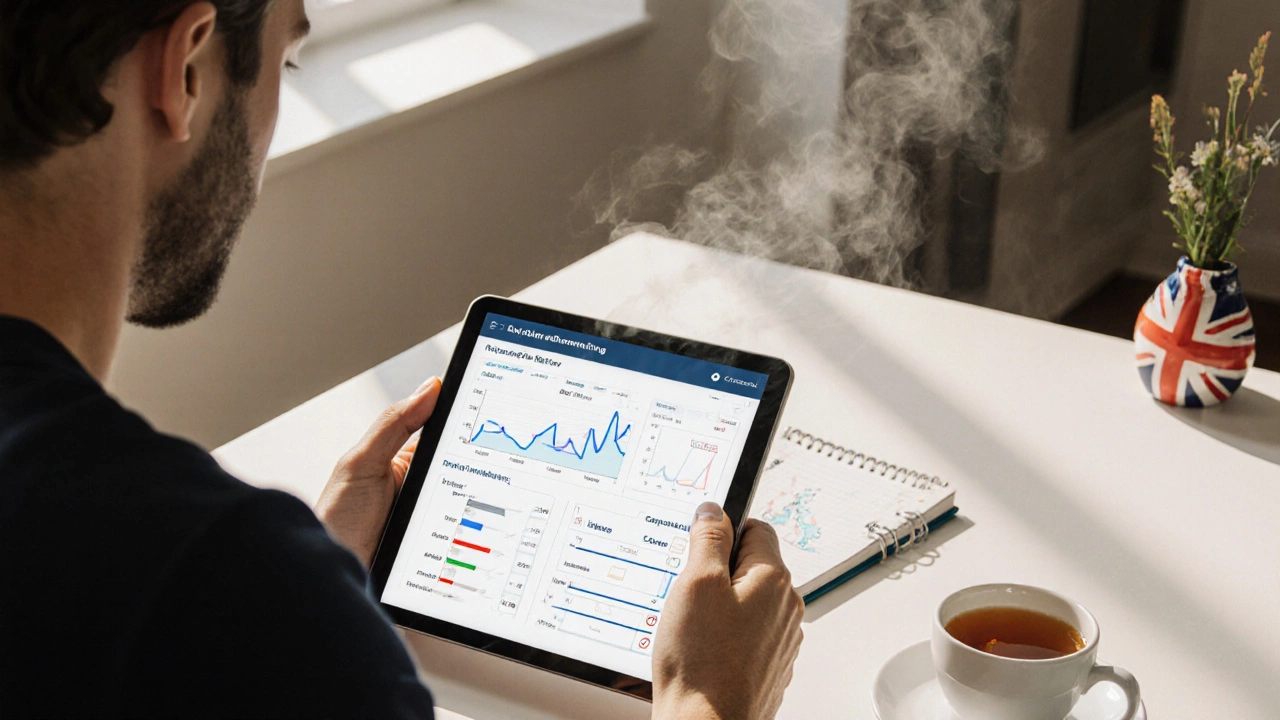Understanding Pension Plans: Basics, Types, and How They Work
 Oct, 4 2025
Oct, 4 2025
Pension Plan Comparison Calculator
Plan Comparison Results
When you hear the term pension plan is a retirement savings arrangement that provides regular income after you stop working, you might wonder what it really means for you. This guide breaks down the concept, walks through the main varieties, and shows how to decide if a pension fits your retirement picture.
Quick Takeaways
- A pension plan is a long‑term savings vehicle that pays you a steady stream once you retire.
- Two big families exist: defined benefit (employer promise) and defined contribution (your savings).
- Common U.S. examples include 401(k) and IRA, while many countries have state‑run schemes.
- Key factors when choosing: employer involvement, fees, investment options, and payout flexibility.
- Avoid common pitfalls like early withdrawals and ignoring inflation.
What Exactly Is a Pension Plan?
A pension plan is essentially a contract that aims to turn years of work into a reliable income stream later in life. It pools contributions-either from you, your employer, or both-and invests them so they grow over time. When you reach the retirement age set by the plan, you start receiving payments, either as a lump sum or a regular monthly amount.
Think of it as a paycheck that’s delayed. Instead of getting money every two weeks, you set aside a portion now and collect it later. The magic lies in compounding: the earlier you start, the more the money can multiply.
How Does a Pension Plan Work?
Every pension plan follows a simple three‑step cycle: contribution, investment, and distribution.
- Contribution: You or your employer deposit a set amount each pay period. Some plans automatically deduct a percentage of your salary.
- Investment: The pooled money is placed in a mix of assets-stocks, bonds, real‑estate funds, or other vehicles-chosen by the plan administrator.
- Distribution: When you hit the plan’s retirement age, the accumulated balance is turned into regular payouts, often adjusted for inflation.
Each step involves decisions that affect how much you’ll receive. For example, higher contribution rates or more aggressive investments can boost your eventual income, but they also raise risk.
Major Types of Pension Plans
Two primary categories dominate the pension landscape: defined benefit and defined contribution.
Defined benefit plan is an employer‑guaranteed scheme where the retirement payout is calculated using a formula based on salary and years of service. The employer bears investment risk, and the amount you receive is usually predictable.
In contrast, a defined contribution plan is a system where contributions are fixed but the final benefit depends on how the investments perform. Here, you own the account, and the market decides the final value.
Below are the most popular examples you’ll encounter:
- 401(k) is a U.S. employer‑sponsored defined contribution plan that lets employees defer pre‑tax wages into investment accounts.
- Individual Retirement Account (IRA) is a personal savings vehicle that offers tax‑advantaged growth, available to anyone with earned income.
- Annuity is a contract with an insurance company that converts a lump‑sum payment into a guaranteed income stream.
- Employer‑sponsored retirement is any plan offered by a company, such as a pension or profit‑sharing arrangement, that helps staff save for retirement.
- Social Security is a government‑run benefit that provides a basic income to retirees based on their work history and contributions.

Comparison: Defined Benefit vs. Defined Contribution
| Aspect | Defined Benefit | Defined Contribution |
|---|---|---|
| Payout certainty | Fixed based on formula (high certainty) | Depends on investment performance (variable) |
| Who bears investment risk? | Employer | Employee |
| Typical contributors | Large corporations, public sector | Most private employers, individuals |
| Portability | Low - often tied to one employer | High - can roll over to new employer or IRA |
| Common examples | Traditional public‑sector pensions | 401(k), IRA, Roth IRA |
Benefits and Drawbacks to Consider
Every pension option carries pros and cons. Here’s a quick reality check.
- Predictable income: Defined benefit plans give you a steady paycheck, helping you budget without guessing.
- Tax advantages: Contributions often reduce taxable income, and growth is tax‑deferred.
- Employer matching: Many 401(k)s include a match, which is essentially free money.
- Flexibility: Defined contribution plans let you choose investments and adjust contributions.
- Risk exposure: In a defined contribution plan, a market crash close to retirement can shrink your nest egg.
- Fees: Some annuities and managed funds charge high administrative fees that eat returns.
- Portability: Changing jobs can be painless with a 401(k) rollover, but moving out of a defined benefit scheme may lock you into a specific payout formula.
How to Choose the Right Pension Plan for You
Start with a self‑audit: How long until retirement? What’s your risk tolerance? Do you have an employer that offers a match?
- Assess employer offers: If your company provides a defined benefit plan, find out the vesting schedule and formula. If a 401(k) match exists, aim to contribute at least enough to capture the full match.
- Calculate needed retirement income: A common rule of thumb suggests you’ll need about 70‑80% of your pre‑retirement earnings. Use an online calculator to estimate the total savings required.
- Test different contribution levels: Increase your deferral rate by 1‑2% each year until you hit your target. Higher contributions lower taxable income today.
- Pick an investment mix: Younger workers can lean toward stocks (higher growth), while those nearing retirement should shift toward bonds (stability).
- Watch fees: Compare expense ratios of available funds. Even a 0.5% fee can shave thousands off a $200,000 balance over 20 years.
- Plan for inflation: Choose options that offer cost‑of‑living adjustments (COLA) or consider supplementing with an inflation‑linked annuity.
Document your choices in a simple spreadsheet: contribution rate, projected balance, expected monthly payout, and any employer match. Review it annually and adjust as life changes.
Common Mistakes and How to Avoid Them
- Waiting too long: Delaying contributions reduces compounding power. Even a few years can mean a big gap.
- Ignoring employer match: If your boss matches 4%, contributing only 2% leaves free money on the table.
- Taking early withdrawals: Early cash‑outs trigger taxes and penalties, shrinking your retirement fund.
- Choosing high‑fee funds: Fees compound negatively; opt for low‑cost index funds where possible.
- Not diversifying: Putting all eggs in one asset class makes you vulnerable to market swings.
Set up automatic contributions and let the system work for you-this removes the temptation to skip a month.
Next Steps After You’ve Picked a Plan
Now that you know the landscape, here’s a quick action plan:
- Log into your employer’s benefits portal and enroll in the offered pension or 401(k) program.
- Set the contribution percentage to at least the employer match threshold.
- Choose a diversified, low‑cost fund lineup (e.g., a total‑stock market index, a total‑bond index, and an international equity fund).
- Schedule an annual check‑in with a financial adviser or use an online tool to keep the plan on track.
- Consider opening an IRA for extra tax‑advantaged space if you can max out the employer plan.
Following these steps turns the abstract idea of a pension plan into a concrete, growing retirement safety net.

Frequently Asked Questions
What’s the difference between a pension and a 401(k)?
A traditional pension (often a defined benefit plan) guarantees a set monthly amount based on salary and years of service, while a 401(k) is a defined contribution plan where the eventual payout depends on how your investments perform.
Can I have both a pension and an IRA?
Yes. Having a pension provides a baseline income, and an IRA lets you add more tax‑advantaged savings on top of that.
Do I lose my pension if I change jobs?
Most defined benefit plans are vested after a certain number of years. If you’ve met the vesting period, you keep the accrued benefit, though you won’t earn more after you leave.
How are pension withdrawals taxed?
Withdrawals are generally taxed as ordinary income because contributions were made pre‑tax. Some plans offer Roth options where withdrawals are tax‑free.
What happens to my pension if my employer goes bankrupt?
In many countries, pension assets are held in a separate trust, protecting them from creditors. However, defined benefit promises can be at risk, so it’s wise to check if your plan is insured by a government agency.
